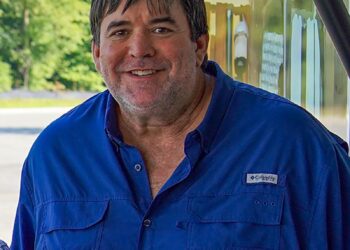Construction equipment dealers in fast-growing U.S. regions are capitalizing on demand driven by large infrastructure projects and a surge in homebuilding in the wake of the $1.2 trillion federal infrastructure bill signed in 2021.
As of May, $454 billion of the $1.2 trillion plan had been committed to infrastructure projects such as roads, public transit, airports, EV charging and water treatment, according to the White House. The bill earmarked about $110 billion for roads, bridges and major highway projects over five years.
Homebuilding, which benefits from increased infrastructure spending as it supports new subdivisions, is projected to rise 4.7% in 2024 and 4.2% in 2025, according to the National Association of Home Builders.
As infrastructure and residential construction accelerate, some equipment dealers in high-growth areas are reaping the benefits.
In North Texas, for instance, demand has been steady for the past few years despite challenges such as tight lending standards and equipment depreciation, Matthew Isgrig, a sales representative at Landmark Equipment in Fort Worth, Texas, told Equipment Finance News.
“Overall, things have been really steady,” he said. “I haven’t had any huge months this year, but they’ve all been above average, and I’m not far off from where I was last year.”
It’s been a similar story for Bobcat dealer Triangle Equipment Group, Sales Manager Kris Realander told EFN. Realander said he felt lucky that his company, which has locations in Raleigh, N.C., Wilmington, N.C. and Myrtle Beach, S.C., could meet growth goals during a time of industry hardship.
“If our goal this year was to achieve what we did last year, or have a little bit of growth, that’s a win,” he said. “Here in the Southeast, we do very, very well.”
The Myrtle Beach and Wilmington areas ranked in the top 10 fastest-growing metro areas for 2023, according to the U.S. Census Bureau.
Large projects equal large equipment
Infrastructure projects can generate a wave of new customers. Large highway projects, in particular, present opportunities for dealers to sell heavy-duty construction equipment, Rob Jackson, sales director at Raleigh, N.C.-based Gregory Poole Equipment Co., told EFN.
“Whether it’s the outer loop of [Interstate] 540 or the larger bypasses that we have going on, you’re talking about some pretty heavy equipment — articulated trucks, large excavators, compactors, dozers,” he said. “That’s great business for us.”
The second phase of the 540 loop project started earlier this year and comprises six interchanges, 24 bridges and 14 culverts, according to the U.S. Department of Transportation. It’s set to cost $1.3 billion, including $417 million in federal funding.
Gregory Poole, which has 14 locations in North Carolina, has seen an influx of out-of-state customers in recent years looking to take advantage of infrastructure growth around Raleigh and Wilmington, Jackson said. The federal government in July provided $242 million for the $485 million Cape Fear Memorial Bridge replacement project in Wilmington, according to the Department of Transportation.
Early stages of infrastructure projects, such as land-clearing for new subdivisions, also lead to an uptick in heavy-duty sales, Triangle Group’s Realander said.
“When it comes to clearing property, that’s where our 10,000- to 12,000-pound units and larger excavators come into play,” he said.
Bobcat’s largest excavator, the E165, weighs nearly 40,000 pounds and costs roughly $212,000 new, according to Triangle Group’s website.

Boosting all sectors
Infrastructure projects can buoy the construction equipment industry as a whole. In Central Texas and the Dallas-Fort Worth regions, a surge in highway projects driven by population growth has bolstered the construction equipment market beyond sales, Lori Bunger, vice president of sales and used equipment at San Antonio-based Holt Cat, told EFN.
“We’ve seen continued demand in the areas of equipment rental, new- and used-equipment sales and machine service,” she said. “Much of this can be attributed to infrastructure and real estate expansion and growth in our regions.”
Texas has received $33.2 billion in federal infrastructure funds since the $1.2 trillion bill was signed in 2021, the second most of any state, according to the White House. In March, the city of Austin was awarded a $105.2 million federal grant for the $4.5 billion I-35 expansion, according to a release. Holt Cat’s Austin location sits along I-35.
The equipment finance sector is also zeroing in on the mega projects, Luke Smith, west region sales manager at Wells Fargo Equipment Finance, told EFN. A mega construction project is one that costs at least $25 million and takes more than a year to complete, according to the U.S. Department of Labor.
“We have a lot of customers that are doing work on roads, bridges, tunnels, power lines, etc.,” Smith said. “Our group is mostly focused on infrastructure-related contractors. So, we tend to monitor the money being spent and invested on those larger jobs.”
More infrastructure spending is supporting equipment-finance demand in states such as California and Arizona, Smith said. California has received $45.1 billion for infrastructure since the 2021 bill, the most of any state, while Arizona has secured the seventh most with $15.4 billion, according to the White House.
Small-town dealers champing at bit
While dealers in some metro areas have already been reaping the benefits of booming development, others are waiting for the federal infrastructure funds to materialize. The $454 billion already committed has gone toward 56,000 projects in 4,500 communities across the country.
Equipment dealers in rural towns on the outskirts of growing metros may be poised to benefit as funds continue to roll out, Gregory Poole’s Jackson said.
“Some of the smaller, rural towns have not seen much investment,” he said. “For us, it would be nice to see some federal spending going that way, especially if things were to potentially slowdown in the second half next year.”
Gregory Poole’s location in Garner, N.C — a town of roughly 34,000 people that’s about six miles south of Raleigh — is one dealership that could benefit from incoming funds, as it intersects with the second phase of the Route 540 loop project.
Domino effect
While major infrastructure projects may initially drive larger construction companies to dealer lots, many winning bidders often hire smaller contractors to complete jobs, Wells Fargo’s Smith said.
“Not all of those larger companies self-perform their work,” he said. “While they may win a $50 million or $100 million job to expand the lane on a highway, build a new road or fix a bridge, they [subcontract] a lot of that work out to local contractors.”
However, the number of subcontractors hired for mega projects might be overstated, Joe Rexin, owner of Long Beach, Calif.-based Rexin Equipment, told EFN.
“When you hear of these big infrastructure projects, like on the [Interstate] 405, it looks wonderful in the news, but it impacts five contractors and then a handful of large subs,” Rexin said. “But they’re large subs. I mean, the big boys. So, if I hear of the 405 project, it doesn’t get me excited at all. I’m getting nothing out of it.”
The $1.9 billion I-405 improvement project was completed in December 2023, according to the Orange County Transportation Authority. Another $163.9 million project on I-405 is underway and slated for completion in 2027, according to the California Department of Transportation.
Homebuilding clears compact machinery

Increased homebuilding — due to infrastructure projects or population growth — typically ignites demand for compact machinery because contractors need smaller equipment to navigate residential lots, Triangle Group’s Realander said.
Contractors “need those small pieces to get around,” he said. “It’s almost like adding another two people because you can have one guy riding a piece of equipment and another guy on the ground, but that unit is carrying weight and getting into tight places that a laborer could do with a wheelbarrow, but it would take multiple trips. So, we’ve noticed that’s actually worked very well in the densely populated areas.”
In 2023, 33.4 building permits were issued per every 1,000 existing homes in the Raleigh-Cary metro, ranking second in the nation, according to research firm Construction Coverage.
Rexin said his company also benefits from residential construction as demand for compact equipment has soared after California passed a law in 2019 allowing more homeowners to add accessory dwelling units to their properties.
Roughly 20% of newly constructed homes in California were ADUs in 2023, according to the California Department of Finance.
Urban growth also increases demand for lighter machinery as people purchase undeveloped land, Gregory Poole’s Jackson said. In fast-growing metros like Raleigh and Wilmington, for instance, large development tracts are becoming increasingly scarce, yielding relatively small residential projects.
“Now, what we’re seeing are these smaller, 10- to 20- acre parcels that won’t require as much dirt moving but will require small construction equipment,” he said. “The [compact construction equipment] business has been relatively flat this year, but that’s still a good thing, because we’re coming off a record year.”









